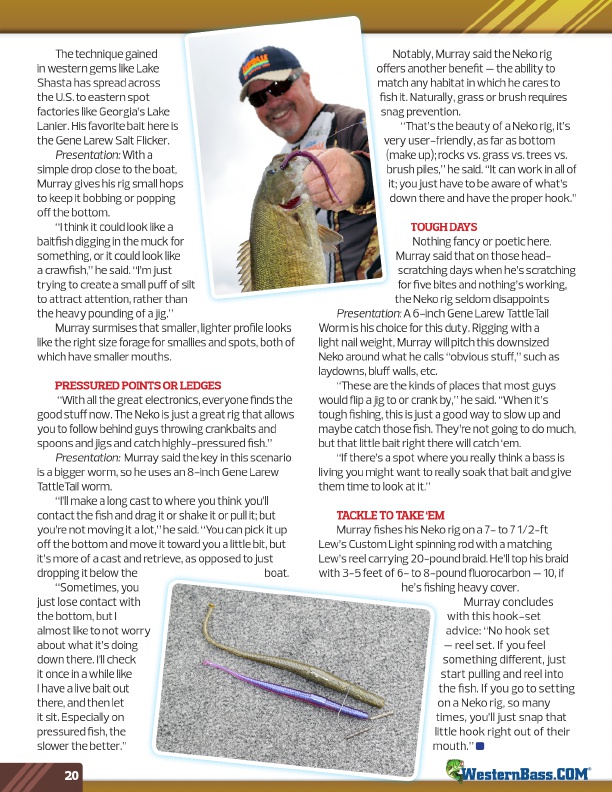
The technique gained in western gems like Lake Shasta has spread across the U.S. to eastern spot factories like Georgia’s Lake Lanier. His favorite bait here is the Gene Larew Salt Flicker.
Presentation: With a simple drop close to the boat, Murray gives his rig small hops to keep it bobbing or popping off the bottom.
“I think it could look like a baitfish digging in the muck for something, or it could look like a crawfish,” he said. “I’m just trying to create a small puff of silt to attract attention, rather than the heavy pounding of a jig.”
Murray surmises that smaller, lighter profile looks like the right size forage for smallies and spots, both of which have smaller mouths.
PRESSURED POINTS OR LEDGES
“With all the great electronics, everyone finds the good stuff now. The Neko is just a great rig that allows you to follow behind guys throwing crankbaits and spoons and jigs and catch highly-pressured fish.”
Presentation: Murray said the key in this scenario is a bigger worm, so he uses an 8-inch Gene Larew TattleTail worm.
“I’ll make a long cast to where you think you’ll contact the fish and drag it or shake it or pull it; but you’re not moving it a lot,” he said. “You can pick it up off the bottom and move it toward you a little bit, but it’s more of a cast and retrieve, as opposed to just
dropping it below the
boat.
“Sometimes, you just lose contact with the bottom, but I almost like to not worry about what it’s doing down there. I’ll check it once in a while like I have a live bait out there, and then let it sit. Especially on pressured fish, the slower the better.”
20
Notably, Murray said the Neko rig offers another benefit — the ability to match any habitat in which he cares to fish it. Naturally, grass or brush requires snag prevention.
“That’s the beauty of a Neko rig, it’s
very user-friendly, as far as bottom
(make up); rocks vs. grass vs. trees vs.
brush piles,” he said. “It can work in all of
it; you just have to be aware of what’s
down there and have the proper hook.”
TOUGH DAYS
Nothing fancy or poetic here.
Murray said that on those head-
scratching days when he’s scratching
for five bites and nothing’s working,
the Neko rig seldom disappoints
Presentation: A 6-inch Gene Larew TattleTail Worm is his choice for this duty. Rigging with a light nail weight, Murray will pitch this downsized Neko around what he calls “obvious stuff,” such as laydowns, bluff walls, etc.
“These are the kinds of places that most guys would flip a jig to or crank by,” he said. “When it’s tough fishing, this is just a good way to slow up and maybe catch those fish. They’re not going to do much, but that little bait right there will catch ‘em.
“If there’s a spot where you really think a bass is living you might want to really soak that bait and give them time to look at it.”
TACKLE TO TAKE ‘EM
Murray fishes his Neko rig on a 7- to 7 1/2-ft Lew’s Custom Light spinning rod with a matching Lew’s reel carrying 20-pound braid. He’ll top his braid with 3-5 feet of 6- to 8-pound fluorocarbon — 10, if
he’s fishing heavy cover.
Murray concludes
with this hook-set
advice: “No hook set
— reel set. If you feel
something different, just
start pulling and reel into
the fish. If you go to setting
on a Neko rig, so many
times, you’ll just snap that
little hook right out of their
mouth.”
®